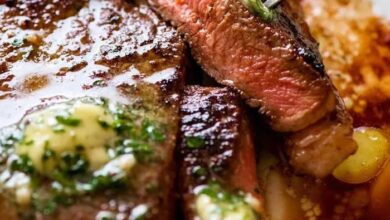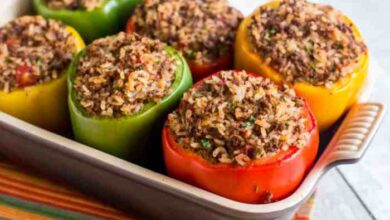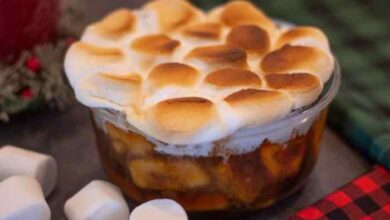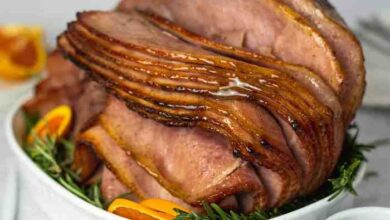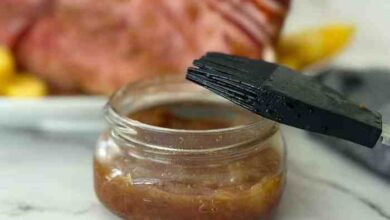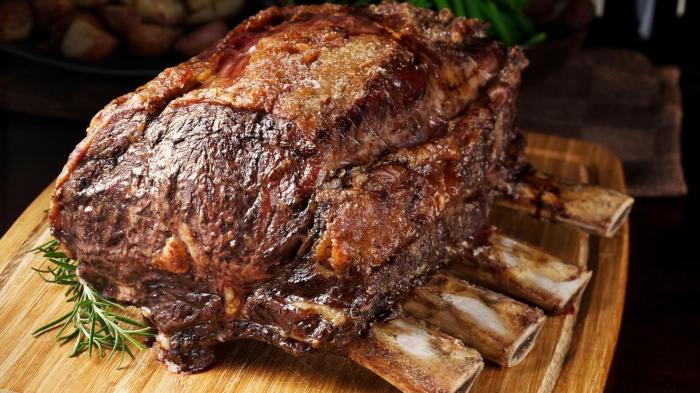
Bone-In Prime Rib Recipes: Mastering the Perfect Roast
Bone in prime rib recipes – Bone-in prime rib recipes are the ultimate centerpiece for any special occasion, promising a succulent and flavorful meal that will impress even the most discerning palate. From understanding the different cuts and roasting methods to mastering the art of seasoning and carving, this comprehensive guide will equip you with the knowledge and skills to create a truly unforgettable prime rib experience.
Whether you’re a seasoned chef or a novice cook, this guide will take you through every step, from selecting the perfect cut to achieving a crispy crust and juicy interior. We’ll explore various techniques, including oven roasting, slow roasting, and reverse searing, ensuring you find the method that best suits your preferences and time constraints.
Prime Rib Basics
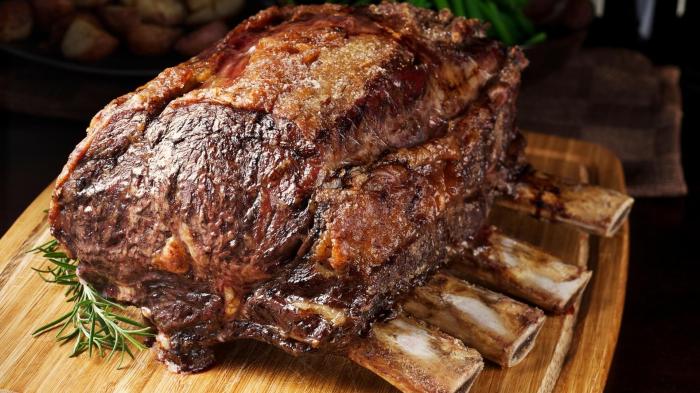
Prime rib, a cut of beef from the rib section, is a true culinary masterpiece. It’s renowned for its rich flavor, tender texture, and impressive presentation, making it a perfect choice for special occasions and celebratory meals. Understanding the different cuts and techniques for preparing prime rib is crucial for achieving the best results.
Cuts of Prime Rib
Prime rib is typically cut from the 6th to 12th ribs of a beef carcass. These ribs can be divided into different cuts, each with its own characteristics.
- Standing Rib Roast:This is the most common cut, consisting of 3 to 7 ribs, with the bone intact. It’s a large and impressive roast, ideal for feeding a crowd.
- Rib Roast:This cut is smaller than the standing rib roast, typically containing 2 to 3 ribs. It’s a good choice for smaller gatherings.
- English Cut Rib Roast:This cut is similar to the standing rib roast, but it’s typically cut from the 7th to 12th ribs. It’s known for its even distribution of fat and lean meat.
Bone-In vs. Boneless Prime Rib
Prime rib can be purchased either bone-in or boneless. Bone-in prime rib offers a more traditional and flavorful experience, as the bone helps to retain moisture and impart flavor during roasting. Boneless prime rib is more convenient to carve and can be easier to cook evenly, but it may lack the depth of flavor found in bone-in roasts.
Roasting Temperature and Time
The optimal roasting temperature for prime rib is 450°F (232°C) for the first 15 minutes, followed by a reduction to 325°F (163°C) for the remainder of the cooking time. The roasting time depends on the size and weight of the roast.
A general rule of thumb is to allow 15-20 minutes per pound for medium-rare prime rib.
For a 4-pound prime rib, you’ll need to roast it for approximately 1 hour at 450°F, followed by 1 hour and 30 minutes to 2 hours at 325°F.
Bone-in prime rib is a real showstopper, but sometimes you crave something a little lighter. That’s where a comforting bowl of instant pot split pea and ham soup comes in. It’s a perfect way to use up leftover ham and a great way to warm up on a chilly day.
Plus, it’s a fantastic side dish to accompany a perfectly roasted prime rib.
Resting Prime Rib
After roasting, it’s crucial to allow the prime rib to rest for at least 15-20 minutes before carving. This allows the juices to redistribute throughout the meat, resulting in a more tender and flavorful roast. The resting time also helps to ensure that the meat is cooked evenly throughout.
Preparing the Prime Rib
Now that you’ve chosen your prime rib and have a basic understanding of its anatomy, it’s time to prepare it for roasting. This involves a few essential steps, including seasoning, tying, and, of course, preheating your oven.
Seasoning Options
The key to a flavorful prime rib is a good seasoning. You can choose from a variety of options, each adding its unique flavor profile.
Dry Rubs
Dry rubs are a popular choice for prime rib, as they adhere well to the meat and create a crispy crust. They typically consist of a blend of spices, herbs, and sometimes salt and pepper.
- Classic Dry Rub:A simple but effective blend of salt, pepper, garlic powder, onion powder, and paprika.
- Herbed Dry Rub:Incorporates fresh or dried herbs like rosemary, thyme, oregano, and parsley for a more aromatic flavor.
- Spicy Dry Rub:Adds a kick with chili powder, cayenne pepper, or other spicy ingredients.
Marinades
Marinades are liquid-based mixtures that tenderize and flavor the meat. They can be used for a few hours or overnight, depending on the recipe.
Bone-in prime rib is a showstopper, especially when you pair it with a creamy, comforting side dish. For me, nothing beats the rich flavor of slow cooker creamed corn. I love how the slow cooker brings out the sweetness of the corn and creates a luxuriously smooth texture.
You can find a fantastic recipe for slow cooker creamed corn on the Cerita Kuliner website. This side dish is a perfect complement to the hearty flavors of the prime rib, creating a meal that’s both elegant and satisfying.
- Wine Marinade:A classic choice, often featuring red wine, garlic, and herbs.
- Soy Marinade:A savory option that adds umami flavor, often incorporating soy sauce, ginger, and garlic.
- Citrus Marinade:Brightens the flavor with citrus juices like lemon, lime, or orange, often combined with herbs and spices.
Using a Meat Thermometer
A meat thermometer is essential for ensuring your prime rib is cooked to perfection. The USDA recommends cooking prime rib to an internal temperature of 145°F (63°C) for medium-rare.
A meat thermometer is a valuable tool for monitoring the internal temperature of the prime rib, ensuring it’s cooked to your desired level of doneness.
Tying the Prime Rib
Tying the prime rib with butcher’s twine helps maintain its shape during cooking and prevents the meat from drying out. It also ensures even cooking throughout.
Bone-in prime rib is a classic, elegant dish that’s perfect for special occasions. It’s a bit of a commitment, but the reward is well worth it. And while you’re planning your menu, don’t forget a sweet treat like this passover banana coffee cake , which is surprisingly easy to make and always a crowd-pleaser.
Speaking of crowd-pleasers, the aroma of a slow-roasted prime rib will have your guests salivating before they even reach the table!
- Gather your supplies:You’ll need butcher’s twine, a sharp knife, and a cutting board.
- Prepare the twine:Cut a length of twine about 3-4 times the length of the prime rib.
- Tie the first knot:Place the twine around the prime rib, about 1 inch from the fat cap. Tie a secure knot.
- Continue tying:Tie additional knots along the length of the prime rib, about 2 inches apart. Make sure the knots are tight but not too constricting.
- Secure the final knot:Tie a final knot near the other end of the prime rib.
Roasting Methods
Prime rib is a majestic cut of meat that deserves a roasting method that will bring out its best qualities. There are several methods to choose from, each with its own unique characteristics and benefits.
Oven Roasting
Oven roasting is the most traditional and straightforward method for cooking prime rib. It involves placing the seasoned roast in a preheated oven and cooking it until it reaches the desired internal temperature. The oven’s consistent heat ensures even cooking, resulting in a juicy and tender roast.
Oven Roasting Temperature and Time
| Internal Temperature | Time |
|---|---|
Rare (125°F
|
15-20 minutes per pound |
Medium Rare (130°F
|
18-25 minutes per pound |
Medium (135°F
|
20-30 minutes per pound |
Medium Well (140°F
|
25-35 minutes per pound |
Well Done (145°F
|
30-40 minutes per pound |
Slow Roasting
Slow roasting involves cooking the prime rib at a lower temperature for a longer period. This method allows the meat to cook slowly and evenly, resulting in a more tender and flavorful roast.
The lower temperature also prevents the meat from drying out.
Slow Roasting Temperature and Time
| Internal Temperature | Time |
|---|---|
Rare (125°F
|
250°F for 2-3 hours |
Medium Rare (130°F
|
250°F for 3-4 hours |
Medium (135°F
|
250°F for 4-5 hours |
Medium Well (140°F
|
250°F for 5-6 hours |
Well Done (145°F
|
250°F for 6-7 hours |
Reverse Searing
Reverse searing is a technique that involves cooking the prime rib at a low temperature for an extended period, followed by a quick sear at a high temperature. This method allows the meat to cook evenly and retain moisture while developing a crispy crust.
Reverse Searing Stages
- Low and Slow:The prime rib is cooked at a low temperature (200°F – 225°F) for several hours until it reaches an internal temperature of 125°F for rare, 130°F for medium-rare, or 135°F for medium. This slow cooking process ensures that the meat is cooked evenly and retains moisture.
- Rest:After the low and slow cooking, the prime rib is allowed to rest for 30 minutes to an hour. This allows the meat to redistribute its juices and become even more tender.
- Sear:The rested prime rib is then seared over high heat (450°F – 500°F) for 5-10 minutes per side. This quick sear creates a crispy crust and adds a delicious flavor to the meat.
Tips for Achieving a Crispy Crust, Bone in prime rib recipes
- Pat the roast dry:Before searing, pat the prime rib dry with paper towels to remove any excess moisture. This will help the crust to brown and crisp up.
- Use high heat:A high temperature is essential for creating a crispy crust. Sear the roast over a hot grill, cast iron skillet, or in a very hot oven.
- Don’t overcrowd the pan:If you are searing the roast in a pan, make sure there is enough space for the heat to circulate around the meat. Overcrowding the pan will prevent the roast from browning properly.
- Don’t move the roast too much:Avoid moving the roast around too much while searing. This will prevent the crust from forming properly.
Serving and Accompaniments: Bone In Prime Rib Recipes
Prime rib, with its rich flavor and tender texture, deserves an equally impressive presentation and accompanying flavors. The perfect serving temperature and a thoughtful selection of accompaniments elevate the dining experience to a new level.
Ideal Serving Temperature
The ideal serving temperature for prime rib is medium-rare, which translates to an internal temperature of 130-135°F (54-57°C). This temperature ensures that the meat is juicy and flavorful, with a slight pink center. However, personal preferences vary, and some may prefer a slightly more cooked prime rib.
It is crucial to use a meat thermometer to ensure the internal temperature is accurate.
Classic Accompaniments
Prime rib is a versatile dish that pairs well with a wide range of accompaniments. Here is a list of classic pairings to consider:
Vegetables
- Roasted Potatoes:The classic pairing for prime rib, roasted potatoes offer a crispy exterior and fluffy interior that complement the richness of the meat.
- Asparagus:The delicate flavor and bright green color of asparagus add a refreshing contrast to the hearty prime rib.
- Green Beans:Steamed or roasted green beans provide a simple yet satisfying accompaniment.
- Brussels Sprouts:Roasted Brussels sprouts with a touch of balsamic glaze offer a sweet and savory element.
- Carrots:Roasted carrots with herbs like rosemary or thyme provide a subtle sweetness and earthy flavor.
Sauces
- Au Jus:A simple and flavorful sauce made from the drippings of the prime rib, au jus adds richness and depth to the dish.
- Horseradish Cream Sauce:A tangy and creamy sauce that complements the richness of the prime rib.
- Red Wine Sauce:A robust sauce made with red wine, shallots, and herbs, perfect for adding complexity to the flavor profile.
Sides
- Yorkshire Pudding:A light and fluffy batter that is baked in the drippings of the prime rib, Yorkshire pudding is a traditional British accompaniment.
- Garlic Bread:A simple and flavorful side that complements the richness of the prime rib.
- Macaroni and Cheese:A creamy and cheesy side that is a crowd-pleaser.
Simple and Flavorful Gravy Recipe
This simple and flavorful gravy recipe is perfect for serving with prime rib:
Ingredients
- 2 tablespoons butter
- 2 tablespoons all-purpose flour
- 2 cups beef broth
- 1/4 cup red wine (optional)
- Salt and pepper to taste
Instructions
- In a saucepan, melt the butter over medium heat.
- Whisk in the flour and cook for 1 minute, stirring constantly.
- Gradually whisk in the beef broth and red wine (if using), bring to a simmer, and cook for 5 minutes, stirring occasionally.
- Season with salt and pepper to taste.
- Strain the gravy through a fine-mesh sieve to remove any lumps.
- Serve immediately over prime rib.
Plated Prime Rib
Imagine a beautifully plated prime rib, its surface glistening with au jus, resting on a bed of creamy mashed potatoes. A sprig of rosemary adds a touch of greenery, and a side of roasted asparagus offers a vibrant contrast. A small bowl of horseradish cream sauce sits alongside, ready to add a touch of tanginess.
This is a visual representation of a prime rib dish that is as delicious as it is aesthetically pleasing.
Variations and Tips
Prime rib is a classic dish that can be enjoyed in many different ways. Here are some variations and tips to help you elevate your prime rib game.
Seasoning Variations
- Classic Herb Rub:A simple blend of dried rosemary, thyme, garlic powder, salt, and pepper is a timeless choice.
- Spicy Rub:For a kick, add chili powder, paprika, cayenne pepper, and cumin to your herb rub.
- Citrus Rub:Combine dried orange and lemon zest with herbs like rosemary and thyme for a bright and tangy flavor.
- Coffee Rub:The bold flavors of coffee and garlic powder complement the richness of the prime rib beautifully.
- Mustard Glaze:A simple mixture of Dijon mustard, honey, and brown sugar creates a sweet and savory glaze.
Cooking Methods
- Reverse Searing:This method involves cooking the prime rib at a low temperature for an extended period, followed by searing at high heat to achieve a crispy crust. This technique yields a consistently tender and juicy roast.
- Sous Vide:Sous vide cooking involves immersing the prime rib in a temperature-controlled water bath, resulting in precise temperature control and even cooking.
- Smoked Prime Rib:For a smoky flavor, try smoking the prime rib over hickory, mesquite, or applewood chips.
Carving Tips
- Let the Prime Rib Rest:Allow the prime rib to rest for at least 15 minutes after cooking to allow the juices to redistribute. This ensures a more tender and juicy roast.
- Use a Sharp Knife:A sharp carving knife will make slicing the prime rib much easier.
- Carve Against the Grain:Carving against the grain helps to ensure tender slices. The grain of the meat runs in the direction of the muscle fibers.
- Slice Thinly:Thin slices are more tender and easier to eat.
Storing Leftover Prime Rib
- Refrigerate Properly:Refrigerate leftover prime rib in an airtight container within two hours of cooking. It should last in the refrigerator for up to four days.
- Freeze for Later:You can also freeze leftover prime rib for up to three months. To freeze, wrap the prime rib tightly in plastic wrap and aluminum foil.
Using Leftover Prime Rib
- Prime Rib Sandwiches:Slice the leftover prime rib and use it to make delicious sandwiches on crusty bread.
- Prime Rib Hash:Dice the leftover prime rib and use it to make a hearty hash with potatoes, onions, and peppers.
- Prime Rib Soup:Use leftover prime rib bones to make a flavorful broth for a hearty soup.
- Prime Rib Pizza:Slice the leftover prime rib and use it as a topping for a pizza.

